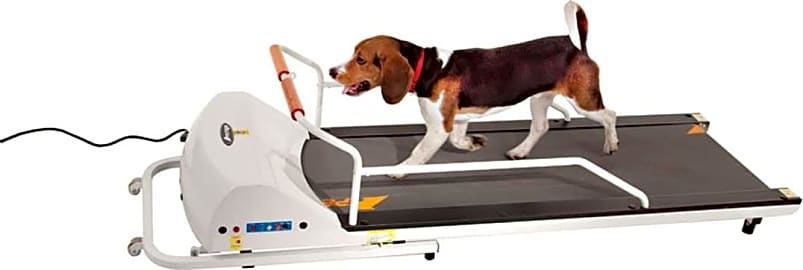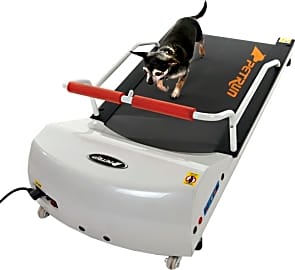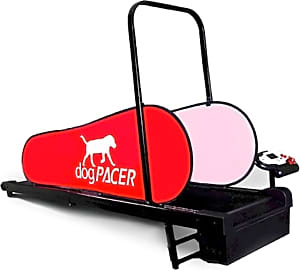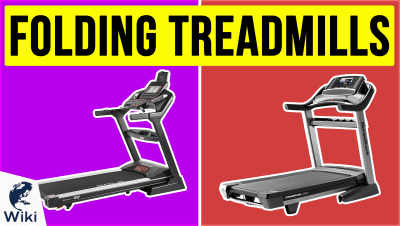The 6 Best Dog Treadmills

This wiki has been updated 36 times since it was first published in October of 2016. One of the greatest gifts we can give our four-legged friends is to keep them healthy and happy by providing an adequate amount of exercise on a regular basis. But if you are not able to take Rover out for a walk every day due to poor weather conditions, schedule conflicts, or personal physical limitations, perhaps one of these dog treadmills will be the next best thing. When users buy our independently chosen editorial choices, we may earn commissions to help fund the Wiki.
Editor's Notes
March 25, 2020:
Safety is a big issue when looking at a treadmill for your dog (or human treadmills, for that matter). Different models offer certain safety features that might be enough to give you peace of mind, while others go above and beyond in securing your pup. The PetSite Fitness Indoor, for example, offers a manually-controlled emergency stop on its remote control, as well as a tether that hooks up to both the console and your dog's collar, working the same way that safety stops do on treadmills and other machines you'll see at your gym.
There's also a crossbar to which you can attach a leash — and plenty of other models have similar attachment points — but if your dog loses its footing and can't get back up, and the mill keeps churning, it could essentially drag him along painfully until you notice. With that in mind, whatever model you get, make sure you're there to keep an eye on your pooch as they use it.
Weight, portability, and size are other vital factors here, as well, with things like the dolly wheels you see on the GoPet Small Medium and others making it much easier to move out of the way when its not in use than it would be if you had to drag it along the carpet. If you've ever had a piece of exercise equipment languish in the middle of your living space, you know how frustrating this can be. Some models are designed to fold up for even easier storage, which may benefit you if you're in a small home or apartment.
Benefits Of A Dog Treadmill
If you really love him, however, getting him to put some miles behind him may be one of the best gifts you can give him.
Your dog is your best friend, so you might be thinking that friends don't let friends run on treadmills. If you really love him, however, getting him to put some miles behind him may be one of the best gifts you can give him.
Many rehab centers use treadmills — especially aquatic ones — to help rehabilitate injured dogs. They allow your dog to rebuild muscle tone and strengthen ligaments, while the buoyancy of the water prevents them from putting their full weight on the injured limb.
Even if you're dog isn't hurt, a treadmill is still softer on its joints than running on pavement. Most dog treadmills are longer than human ones as well, so your fuzzy friend can run with his full, extended stride.
Just like with people, though, a treadmill forces a dog to keep moving. If you've ever tried to jog with your pet, you know that it's a good way to get yourself killed, as every time you reach your top speed, he stops to sniff a flower. When he's on the machine, he has to maintain a controlled speed.
If your pooch is overweight, it gives you an easy and consistent way to trim his waistline. You'll have to pair it with a sensible diet, of course, but the full-body workout he gets from the treadmill will help speed up his weight loss.
Certain behavioral problems can be ameliorated with exercise, so if your dog's destructive, suffers from separation anxiety, or barks excessively, you can try tuckering him out with a few miles on the treadmill.
You'll still need to walk him at least some of the time, of course, as those excursions are as much about bonding as they are about getting physical activity. However, don't be surprised if you find that you both look forward to treadmill time every day.
Well, his treadmill time, anyway. Your treadmill is still under all those old clothes in the guest room.
Teaching Your Dog To Use The Treadmill
If you've struggled to get your dog to walk like a civilized person outdoors, where he has the whole world to move around in, the thought of trying to corral him on a narrow treadmill may be anxiety-inducing. If you take the time to train him correctly and introduce him to it slowly, however, you can soon have him using it like a champ.
The most important thing is to not force it, especially at first. If you spook your dog in the beginning, he'll fear the treadmill. In that case, turning it on may only serve to put him into a barking frenzy — you know, kind of like he does when you vacuum.
Start off with rounds that last thirty seconds or a minute, then build up from there.
Start by introducing him to the machine while it's turned off. Lure him onto it with a treat, and then praise him lavishly when he finally stands on it. Let him sniff around and familiarize himself with it, and encourage him to step on and off repeatedly.
Once he's comfortable with being on it — especially if he's begun to associate it with treats — you can turn it on. Don't try to get him on it just yet; let him watch it, sniff it, whatever he wants to do (well, unless he wants to pee on it). Again, praise and treat him if he doesn't react negatively to it.
When you're ready to try it with him on, set the treadmill on its lowest setting and put him on a leash, then either lift him onto the belt or lure him up there with a treat. Once he's up, it'll be a new experience for him, so give him lots of positive reinforcement, but don't push the issue if he reacts negatively.
If he starts to walk, hold his leash like you would if you were on a regular walk. In fact, you should basically treat it like a walk, being sure to continue rewarding him as you go.
Don't try to go for a full session the first time out. Start off with rounds that last thirty seconds or a minute, then build up from there. Always have him on leash, and always stay right by his side.
Of course, if you really want to make him comfortable while walking, be sure to keep the TV on his favorite channel.
Other Ways To Keep Your Pooch Healthy
You want your dog to live forever. Unfortunately, that's not yet possible (stupid lazy science), but if you keep him as healthy as you can, you can extend the number of years you have to spend with him.
Keeping him at a healthy weight is of paramount importance. Find a food that's well-balanced, and limit how much you feed him every day.
You may want to look into supplements for your hound as well, especially if he's a larger breed.
You may want to look into supplements for your hound as well, especially if he's a larger breed. Conditions like hip dysplasia and arthritis are common in older, heavier dogs, so think about starting him on nutrients like glucosamine and fish oil. Check with your vet first, though.
Exercise is extremely important, of course, so make sure your dog is getting lots of physical activity. Your dog should get thirty minutes to two hours of activity every day, so take him on frequent walks, play fetch with him, and even consider setting up an agility course in your backyard.
Don't skimp on challenging his brain, either. Regular training is fun for both of you, as well as making him a more polite member of society. You can stimulate his mind with puzzle toys, rounds of hide and seek, and scavenger hunts in which you hide food around the house.
The great thing about improving your dog's health is that it's a lot more fun than actually working out yourself, so it also saves you the trouble of coming up with a new excuse not to exercise every day.











